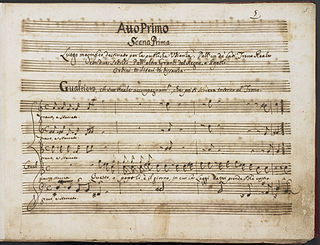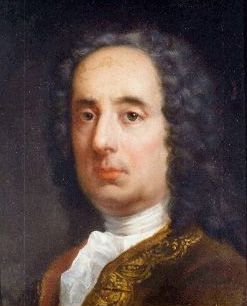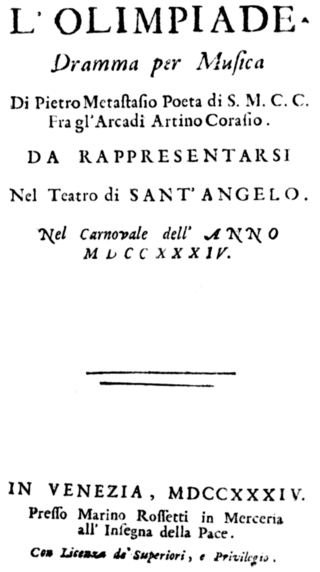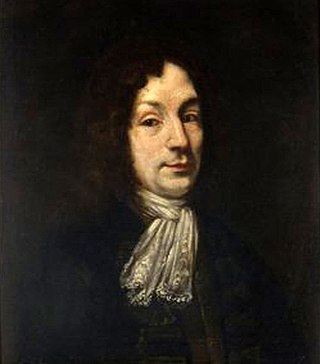
L'Olimpiade is an opera libretto in three acts by Metastasio originally written for an operatic setting by Antonio Caldara of 1733. Metastasio’s plot vaguely draws upon the narrative of "The Trial of the Suitors" provided from Book 6 of The Histories of Herodotus, which had previously been the base for Apostolo Zeno's libretto Gli inganni felici (1695). The story, set in Ancient Greece at the time of the Olympic Games, is about amorous rivalry and characters' taking places to gain the loved one. The story ends with the announcement of two marriages.

Farnace is an opera by Italian composer Antonio Vivaldi, set to a libretto by Antonio Maria Lucchini initially set by Leonardo Vinci during 1724. Vivaldi's setting received its first performance in 1727 at the Teatro Sant'Angelo in Venice. Popular at the time, and revived with great success at the Sporck theater in Prague in 1730, Vivaldi's Farnace slipped into oblivion until the last quarter of the 20th century when it emerged from obscurity.

Bajazet is an Italian opera in 3 acts composed by Antonio Vivaldi in 1735. Its libretto was written by Agostino Piovene. It was premiered in Verona, during the Carnival season of that year. It includes a three-movement sinfonia as an introduction. The story is about the fate of Bajazet after being captured by Tamerlane. The famous aria "Sposa son disprezzata" is from this opera.

Griselda is an opera seria in three acts by the Italian composer Alessandro Scarlatti, the last of Scarlatti’s operas to survive completely today. The libretto is by Apostolo Zeno, with revisions by an anonymous author. Zeno wrote his work in 1701 and it had already been set by Pollarolo and Antonio Maria Bononcini. It is based on the story of Patient Griselda from Boccaccio's tenth day of The Decameron. Scarlatti's opera was first performed at the Teatro Capranica, Rome, in January 1721 with an all-male cast.

Griselda is a dramma per musica in three acts that was composed by Antonio Vivaldi. The opera uses a revised version of the 1701 Italian libretto by Apostolo Zeno that was based on Giovanni Boccaccio's The Decameron. The celebrated Venetian playwright Carlo Goldoni was hired to adapt the libretto for Vivaldi. The opera was first performed in Venice at the Teatro San Samuele on 18 May 1735.

Griselda is an opera in three acts composed by Antonio Maria Bononcini. The opera uses a slightly revised version of the 1701 Italian libretto by Apostolo Zeno that was based on Giovanni Boccaccio's The Decameron. The opera was dedicated to Prince Maximilian Karl von Löwenstein, the Austrian governor of Milan, who died during the opera's world première on 26 December 1718 at the Teatro Regio Ducale in Milan. Nevertheless, Bononcini's opera was well received and enjoyed several revivals during the eighteenth century.

L'Olimpiade is a dramma per musica in three acts that was composed by Antonio Vivaldi. The opera uses an Italian libretto by Pietro Metastasio that was originally written for Antonio Caldara's 1733 opera of the same name. Vivaldi's version premiered in Venice at the Teatro Sant'Angelo on 17 February 1734. The same libretto was to be later set to music by over 50 other composers, including Giovanni Battista Pergolesi in 1735.

Giuseppe Maria Orlandini was an Italian baroque composer particularly known for his more than 40 operas and intermezzos. Highly regarded by music historians of his day like Francesco Saverio Quadrio, Jean-Benjamin de La Borde and Charles Burney, Orlandini, along with Vivaldi, is considered one of the major creators of the new style of opera that dominated the second decade of the 18th century.
Antonio Maria Lucchini or Luchini was an Italian librettist. His texts were set to music by Antonio Vivaldi, Baldassare Galuppi, Leonardo Vinci, and Rinaldo di Capua, among others.

Farnace is an 18th-century Italian opera in 3 acts by the Czech composer Josef Mysliveček. It was composed to a libretto by the Italian poet Antonio Maria Lucchini that is best known from a setting by Antonio Vivaldi first produced at the Teatro Sant'Angelo in Venice for the carnival operatic season of 1727. For a performance in the 1760s, it would only be expected that a libretto of such age would be abbreviated and altered to suit contemporary operatic taste; this libretto was unusually old, even older than all but one of the librettos by Metastasio that continued by be set in the 1760s. The cuts and changes in the text made for the 1767 performance of Mysliveček's opera are not attributable. Indeed, they are quite extensive; not a single one of Lucchini's original aria texts was re-set by Mysliveček. However, it is the same cut libretto of Farnace, with small variants, used by the Neapolitan Davide Perez in his opera for the Regio Teatro of Turin in the 1751 Carnival, and repeated in Rome at the Torre Argentina Theater the following year, and in Messina and Naples in 1753 and again in 1757.

Teatro San Samuele was an opera house and theatre located at the Rio del Duca, between Campo San Samuele and Campo Santo Stefano, in Venice. One of several important theatres built in that city by the Grimani family, the theatre opened in 1656 and operated continuously until a fire destroyed the theatre in 1747. A new structure was built and opened in 1748, but financial difficulties forced the theatre to close and be sold in 1770. The theatre remained active until 1807 when it was shut down by Napoleonic decree. It reopened in 1815 and was later acquired by impresario Giuseppe Camploy in 1819. In 1853 the theatre was renamed the Teatro Camploy. Upon Camploy's death in 1889, the theatre was bequeathed to the City of Verona. The Venice City Council in turn bought the theatre and demolished it in 1894.

Francesco Antonio Mamiliano Pistocchi, nicknamed Pistocchino, was an Italian singer, composer and librettist.
L'incoronazione di Dario is an opera in three acts composed by Giacomo Antonio Perti to an Italian libretto by Adriano Morselli. It was first performed on 13 January 1686, at the Teatro Malvezzi in Bologna. Morselli originally wrote the libretto for Domenico Freschi's opera Dario which premiered at the Teatro San Angelo in Venice in 1685. Other later uses of the libretto include Giuseppe Aldrovandini's 1705 L'incoronazione di Dario and Vivaldi's 1717 L'incoronazione di Dario.
Anna Girò, also known as l'Annina del Prete Rosso, la Nina del Prete Rosso, or l'Annina della Pietà, was the stage name of Anna Maria(?) Maddalena Tessieri, an Italian mezzo-soprano/contralto of the 18th century. She is best remembered for her numerous collaborations with composer Antonio Vivaldi who wrote operatic roles for her. She is the singer who performed the greatest number of Vivaldi's operas, the one who kept them in her repertoire the longest time and who made them known across the largest geographical area.

Luca Antonio Predieri was an Italian composer and violinist. A member of a prominent family of musicians, Predieri was born in Bologna and was active there from 1704. In 1737 he moved to Vienna, eventually becoming Kapellmeister to the imperial Habsburg court in 1741, a post he held for ten years. In 1765 he returned to his native city where he died two years later at the age of 78. A prolific opera composer, he was also known for his sacred music and oratorios. Although his operas were largely forgotten by the end of his own lifetime and most of their scores lost, individual arias as well some of his sacred music are still performed and recorded.

Atenaide is an opera by Antonio Vivaldi to a revised edition of a 1709 libretto by Apostolo Zeno for Caldara. It was first performed at the Teatro della Pergola in Florence on 29 December 1728 for the 1729 Carnival season.

L'oracolo in Messenia is a 1738 opera by Antonio Vivaldi to a libretto by Apostolo Zeno. The opera was composed for the autumn Venetian carnival season of 1738 after Vivaldi took over the Teatro San Angelo from the impresario who had managed it the year before.

Sebastiano Biancardi, known by the pseudonym Domenico Lalli, was an Italian poet and librettist. Amongst the many libretti he produced, largely for the opera houses of Venice, were those for Vivaldi's Ottone in villa and Alessandro Scarlatti's Tigrane. A member of the Accademia degli Arcadi, he also wrote under his arcadian name "Ortanio". Lalli was born and raised in Naples as the adopted son of Fulvio Caracciolo but fled the city after being implicated in a bank fraud. After two years wandering about Italy in the company of Emanuele d'Astorga, he settled in Venice in 1710 and worked as the "house poet" of the Grimani family's theatres for the rest of his career. In addition to his stage works, Lalli published several volumes of poetry and a collection of biographies of the kings of Naples. He died in Venice at the age of 62.

Maria Caterina Negri was an Italian contralto who created numerous roles in 18th-century operas, including many by George Frideric Handel. She primarily portrayed male characters en travesti or female warriors such as Bradamante. Negri was born in Bologna and made her debut there at the age of 15. Her last known performance was in 1744. The date and place of her death are unknown. In its prime, her voice was known for its agility and wide vocal range.

Semiramide is a dramma per musica in three acts by Antonio Vivaldi composed to a libretto by Francesco Silvani.














